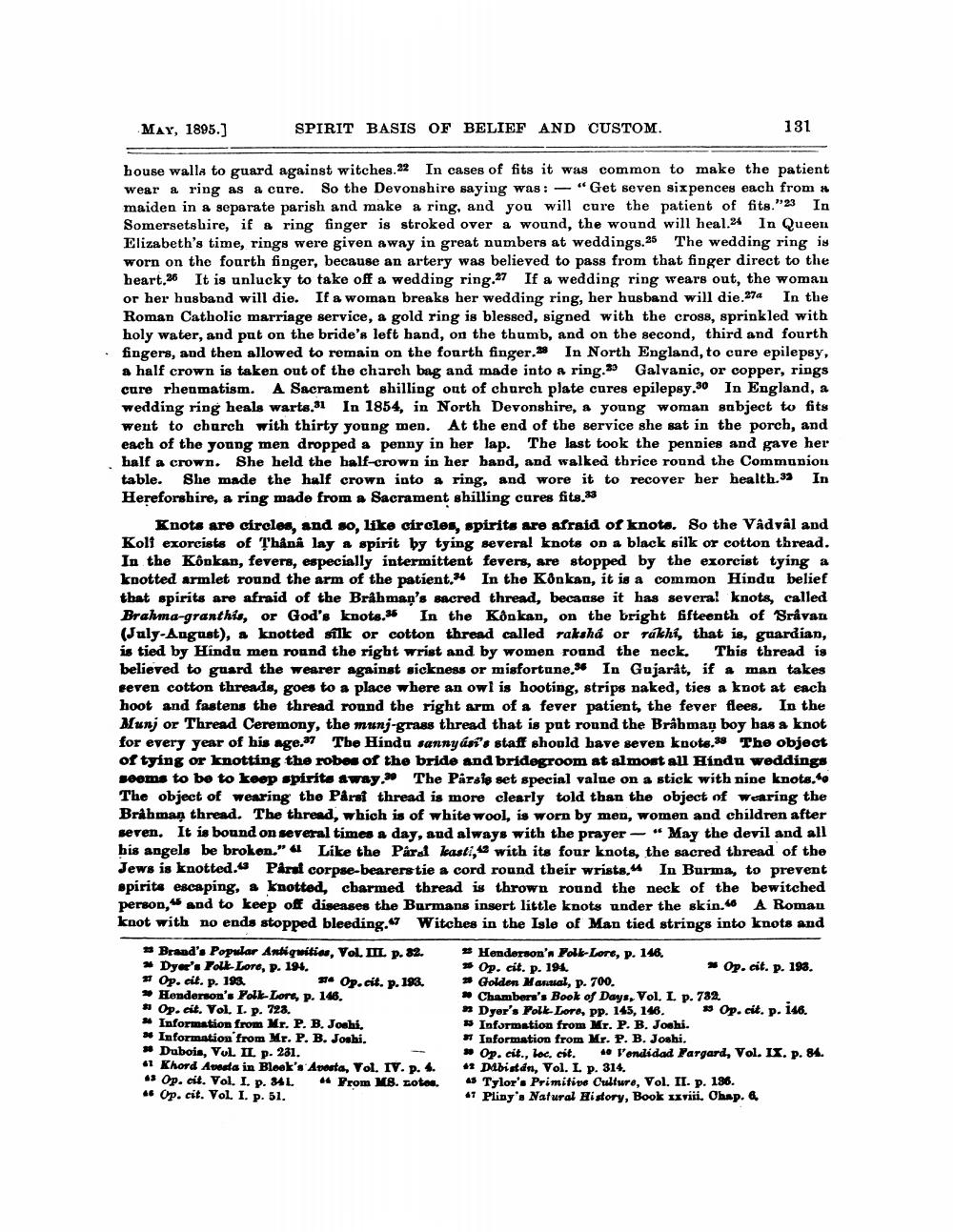________________
MAY, 1895.]
SPIRIT BASIS OF BELIEF AND CUSTOM.
131
house walla to guard against witches 22 In cases of fits it was common to make the patient wear a ring as a cure. So the Devonshire saying was: — "Get seven sixpences each from # maiden in a separate parish and make a ring, and you will cure the patient of fits.”23 In Somersetshire, if a ring finger is stroked over a wound, the wound will heal.24 In Queen Elizabeth's time, rings were given away in great numbers at weddings.25 The wedding ring is worn on the fourth finger, because an artery was believed to pass from that finger direct to the heart.26 It is unlucky to take off a wedding ring.27 If a wedding ring wears out, the woman or her husband will die. If a woman breaks her wedding ring, her husband will die.274 In the Roman Catholic marriage service, a gold ring is blessed, signed with the cross, sprinkled with holy water, and put on the bride's left hand, on the thumb, and on the second, third and fourth fingers, and then allowed to remain on the fourth finger.28 In North England, to care epilepsy, a half crown is taken out of the charch bag and made into a ring.13 Galvanic, or copper, rings cure rheomatism. A Sacrament shilling out of church plate cures epilepay.30 In England, a wedding ring heals warts.81 In 1854, in North Devonshire, a young woman sabject to fits went to church with thirty young men. At the end of the service she sat in the porch, and each of the young men dropped a penny in her lap. The last took the pennies and gave her half a crown. She held the half-crown in her band, and walked thrice round the Communion table. She made the half crown into a ring, and wore it to recover ber health.33 In Hereforshire, a ring made from a Sacrament shilling cures fits.3
Knots are circles, and so, like circles, spirits are afraid of knots. So the Vadval and Koli exorcists of Thank lay a spirit by tying several knots on a black silk or cotton thread. In the Kônkan, fevers, especially intermittent fevers, are stopped by the exorcist tying a kpotted armlet round the arm of the patient. In the Kônkan, it is a common Hindu belief that spirits are afraid of the Brahman's sacred thread, because it has several knots, called Brahma-granthis, or God's knots. In the Kônkan, on the bright fifteenth of Srávan (July-August), a knotted silk or cotton thread called raksha or rakhí, that is, guardian, is tied by Hinda men round the right wrist and by women roand the neck. This thread is believed to guard the wearer against sickness or misfortune. In Gujarat, if a man takes seven cotton threads, goes to a place where an owl is hooting, strips naked, ties a knot at each hoot and fastens the thread round the right arm of a fever patient, the fever flees. In the Munj or Thread Ceremony, the munj-grass thread that is put round the Brabmaş boy has a knot for every year of his age.37 The Hindu sannyúsi's staff should bave seven knots.38 The object of tying or knotting the robes of the bride and bridegroom at almost all Hindu weddings seems to be to keep spirits away. The Parsis set special valne on a stick with nine knots.to The object of wearing the Parsi thread is more clearly told than the object of wearing the Brahman thread. The thread, which is of white wool, is worn by men, women and children after seven. It is bound on several times a day, and always with the prayer - "May the devil and all bis angels be brokon." Like the Para kasti, with its four knots, the sacred thread of the Jews is knotted. Parul corpse-bearers tie a cord round their wrists. In Burma, to prevent spirite escaping, a knotted, cbarmed thread is thrown round the neck of the bewitched person, and to keep of diseases the Burmans insert little knots under the skin. A Roman knot with no ends stopped bleeding. Witches in the Isle of Man tied strings into knots and
** Brand's Popular Antiquities, Vol. III. p. 82. * Dyer's Foll-Lore, p. 194. # Op. cit. p. 195.
• Op.cit. p. 192. · Henderson's Poll-Lors, p. 146. * Op. cit. Vol. I. p. 728. # Information from Mr. P. B. Joshi, * Information from Mr. P. B. Joshi. ** Dubois, VoL II p. 231. 61 Khord Avesta in Bloek's Avesta, Vol. IV. p. 4. *s Op. cit. Vol. I. p. 8L 4 Prom MB. Lotos ++ Op. cit. Vol. I. p. 51.
Henderson'n Polt-Lore, p. 146. * Op. cit. p. 194.
* Op. cit. p. 198. ► Golden Manual, p. 700. * Chambers's Book of Days, Vol. I. p.782. * Dyer's Poll-Lore, pp. 145, 146. Op. cit. p. 146.
Information from Mr. P. B. Joshi. » Information from Mr. P. B. Joshi. » Op. cit., loc. cit. 10 'endidad Pargard, Vol. IX. p. 84. *Dubistan, Vol. L p. 314. 45 Tylor'. Primitive Culture, Vol. II. p. 186. 67 Pliny's Natural History, Book xxviii. Ohap. &




